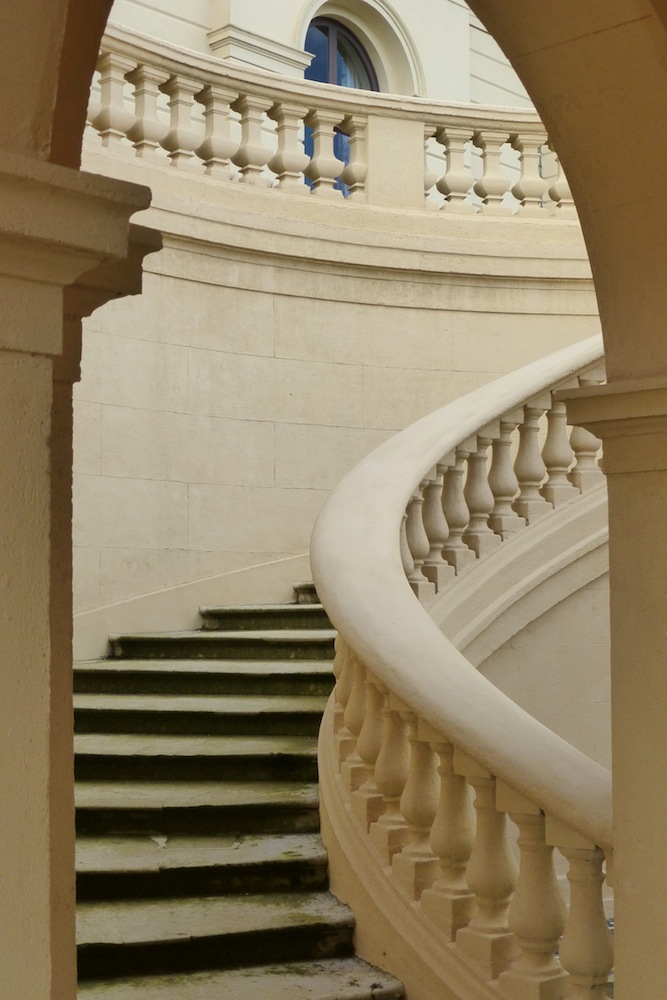Photographs by the author. Special thanks to English Heritage for permitting photography in Osborne House, and for allowing the photographs to be shared on a non-commercial basis. You may use these images without prior permission for any scholarly or educational purpose as long as you (1) credit the photographer and (2) link your document to this URL or cite it in a print document. [Click on all the images to enlarge them.]

The Upper and Lower Terraces from the side of the Pavilion Terrace.
Thomas Cubitt's men built the spectacular Italian terraces at Osborne from 1847-53 to a plan developed by Prince Albert and the Queen's artistic adviser, Ludwig Grüner (1801-1882), with Cubitt himself. They are on the north-east front, and have balustraded upper and lower levels with carved stone embellishments, linked by matching steps on each side. This was a major undertaking, "one of the most substantial operations relating to the making of Osborne" (Lloyd and Pevsner 209). Taken as a whole, these terraces very significantly enhance the Grade I listed building at East Cowes. Their carvings, statues and fountains are also listed, at Grade II.


Two views of the Pavilion Terrace with Ludwig Grüner's large sphinx-based vase in the middle.

The view from the centre of the Upper Terrace.
The Pavilion Terrace, closest to the royal family's private rooms, is where John Francis's statue of Prince Albert's favourite dog, Eos, can be seen. The view from the whole Upper Terrace is magnificent. It takes in Grüner's fountain on the Lower Terrace, crowned with John Bell's Andromeda (1851) and surrounded by marine grotesques by William Theed, and beyond the gardens themselves the sweeping broad walk, with the Solent in the distance.




Left to right: (a) View from the outer edge of the Upper Terrace. (b) View from the Upper Terrace showing the shell alcove, decorated with shells from Osborne's beach. (c) Stone carvings which enliven the balustrades. (d) Elegantly curving steps at the far end of the Upper Terrace.
As well as the parterres themselves, and some significant plants such as the royal myrtle (grown from a sprig from a nosegay given to the Queen by Prince Albert's grandmother), there are beautiful and extensive views at every turn, made more interesting by the terrace landscaping and statuary. From the terrace's outer edge there is a good view of the tiered Venus fountain (again by Grüner) outside the Main Wing, down to the clock-tower at the far end. Stone carvings of urns, eagles, animal heads and sphinxes make interesting punctuation to the views.



Left to right: (a) An alcove on the Lower Terrace bordered by the Magnolia Grandiflora planted by Prince Albert himself, with a sculptured head on a pedestal within. (b) The fierce-looking head of Emile Braun's Jupiter, c.1847, in another niche. (c) One of a pair of greyhounds at the entrance to the Lower Terrace.


Left: One of the wrought-iron garden seats in the grounds. Right: A stone seat dedicated to the memory of John Brown.
Grüner was particularly important in the acquisition and arrangement of the garden statuary, the idea often being to "enhance Osborne's Italianate qualities" (Turner 26). But the granite garden bench on the way from the Lower Terrace to the Swiss Cottage came much later. It has a medallion on the backrest showing a portrait of John Brown, who had graduated from being her gillie (or attendant when riding) in Balmoral to being her regular attendant, and who died in 1883. The inscription below the medallion reads, in gold, "A truer nobler trustier heart,/ more loving or more loyal, never beat/ Within a human breast. Byron" (it is hard to see the punctuation).
Related Material
- Osborne: Exterior
- Osborne: The Pavilion
- Osborne: Main Wing
- Osborne: Durbar Wing
- Sculpture of Eos on the Pavilion terrace
- Walled Garden, Osborne
- Swiss Cottage, Osborne
- Summer house / Children's toolshed, Osborne
- Children's museum, Osborne
- Children's Victoria Fort and Albert Barracks, Osborne
- Queen Victoria's bathing machine, Osborne beach
Bibliography
"Emil Braun (active c.1849): Jupiter." Royal Collection Trust. Web. 15 September 2017.
"History of Osborne." English Heritage. Web. 10 September 2017 (this site has an excellent plan of the whole house).
Lloyd, David W., and Nikolaus Pevsner. Isle of Wight. Buildings of England series. New Haven & London: Yale University Press, 2006.
"Osborne, Isle of Wight, England." Parks and Gardens, UK. Web. 15 September 2017.
Turner, Michael. Osborne. Rev. reprint. English Heritage, 2016.
Created 15 September 2017